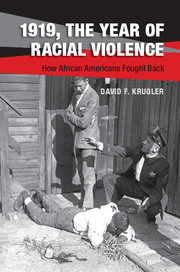Book contents
- Frontmatter
- Dedication
- Contents
- Acknowledgments
- Source Abbreviations and Usage Note
- Introduction
- 1 World War I and the New Negro Movement
- 2 “We Return Fighting”
- 3 Fighting a Mob in Uniform
- 4 Blood in the Streets
- 5 Armed Resistance to the Courthouse Mobs
- 6 Armed Resistance to Economic Exploitation in Arkansas, Indiana, and Louisiana
- 7 “It Is My Only Protection”
- 8 The Fight for Justice
- 9 The Fight for Justice
- 10 Fighting Judge Lynch
- Conclusion
- Bibliography
- Index
- References
6 - Armed Resistance to Economic Exploitation in Arkansas, Indiana, and Louisiana
Published online by Cambridge University Press: 05 December 2014
- Frontmatter
- Dedication
- Contents
- Acknowledgments
- Source Abbreviations and Usage Note
- Introduction
- 1 World War I and the New Negro Movement
- 2 “We Return Fighting”
- 3 Fighting a Mob in Uniform
- 4 Blood in the Streets
- 5 Armed Resistance to the Courthouse Mobs
- 6 Armed Resistance to Economic Exploitation in Arkansas, Indiana, and Louisiana
- 7 “It Is My Only Protection”
- 8 The Fight for Justice
- 9 The Fight for Justice
- 10 Fighting Judge Lynch
- Conclusion
- Bibliography
- Index
- References
Summary
Three riots closed out the year of racial violence. Two occurred in the South, the other in the upper Midwest. The riots shared a significant trait: the violence directed against African Americans originated in the exploitation of agricultural or industrial laborers. To be precise, the violence was a response to black-led or biracial resistance to economic exploitation. In late September, a coalition of white businessmen and planters moved to destroy a newly formed black sharecroppers’ union in Phillips County, Arkansas. The sharecroppers’ armed resistance resulted in a pogrom with a death toll that rivaled – most likely even exceeded – that of Chicago’s. In October, black workers in Gary, Indiana, refused to be scapegoated during a massive strike that idled the city’s steel mills and factories. Meanwhile, in Bogalusa, Louisiana, black lumber workers joined forces with their white co-workers to fight for improved conditions and wages.
In all three places, corporate and municipal authorities used armed vigilantes to suppress laborers’ efforts to improve their economic standing. In Arkansas, U.S. Army troops joined force with these vigilantes. In Gary, federal troops were deployed under the command of General Leonard Wood. True to his statement in Omaha, Wood enthusiastically accepted the help of Gary’s paramilitary voluntary associations to quell the civic disorder brought by the strikes. In Bogalusa, similar organizations worked with corporate guards (in effect, a company police force) to threaten, beat up, and, eventually, murder black and white union organizers.
- Type
- Chapter
- Information
- 1919, The Year of Racial ViolenceHow African Americans Fought Back, pp. 165 - 195Publisher: Cambridge University PressPrint publication year: 2014



